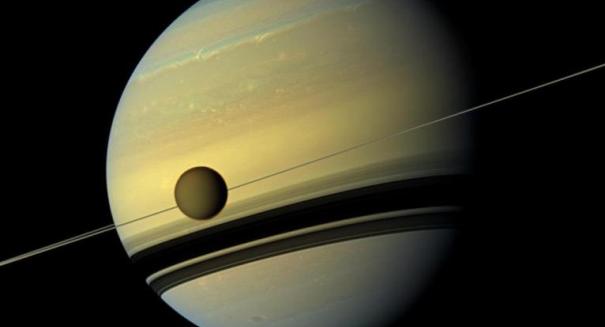
Propylene is reportedly the first molecule to be found on Titan utilizing Cassini's Composite Infrared Spectrometer.
According to a news release from NASA’s Goddard Space Flight Center, NASA has discovered an ingredient of household plastic in Titan’s atmosphere.
The space agency’s Cassini spacecraft has found propylene, a chemical utilized to produce food-storage containers, automobile bumpers and other consumer products, on Saturn’s moon Titan. According to the news release, this is the very first clear-cut identification of the plastic ingredient on any moon or exoplanet.
NASA notes that Titan is the largest of the 53 known moons circling the ringed planet. In fact, it is the second biggest moon in our solar system. The temperature at Titan’s surface is approximately -289 Fahrenheit. Additionally, the moon takes nearly 16 days to finish a full orbit around Saturn.
According to the space agency, a tiny amount of propylene was detected in Titan’s lower atmosphere by the spacecraft’s Composite Infrared Spectrometer (CIRS). This particular instrument determines the infrared light given off by Saturn and its moons in a similar fashion to the way our hands detect the heat emitted from a fire.
Propylene is reportedly the first molecule to be found on Titan utilizing CIRS. By sequestering the same signal at different altitudes within the lower atmosphere, researchers detected the chemical.
“This chemical is all around us in everyday life, strung together in long chains to form a plastic called polypropylene,” said lead author Conor Nixon, a planetary scientist at NASA’s Goddard Space Flight Center. “That plastic container at the grocery store with the recycling code 5 on the bottom — that’s polypropylene.”
CIRS can detect a particular gas gleaming in the lower layers of the atmosphere from its characteristic thermal signature. The hard part is to sequester this particular signature from the signal of all other gasses around it.
Voyager identified all members of the one- and two-carbon families in Titan’s atmosphere. From the three-carbon family, the spacecraft discovered propane (heaviest) and propyne (one of the lightest). However, Voyager was unable to detect the middle chemicals, one of which is propylene.
Despite finding more chemicals in Titan’s atmosphere utilizing ground- and space-based telescopes, propylene remained unfound. It was eventually discovered after an in-depth examination of the CIRS data.
“This measurement was very difficult to make because propylene’s weak signature is crowded by related chemicals with much stronger signals,” said Michael Flasar, Goddard scientist and principal investigator for CIRS. “This success boosts our confidence that we will find still more chemicals long hidden in Titan’s atmosphere.”
Cassini’s mass spectrometer had suggested earlier that propylene might exist in Titan’s upper atmosphere.

“I am always excited when scientists discover a molecule that has never been observed before in an atmosphere,” said Scott Edgington, Cassini’s deputy project scientist at NASA’s JPL. “This new piece of the puzzle will provide an additional test of how well we understand the chemical zoo that makes up Titan’s atmosphere.”
The study’s findings are described in greater detail in the Astrophysical Journal Letters.
What do you think of the discovery? Share your thoughts in the comments section.
Leave a Reply